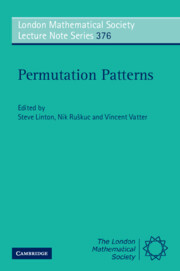Book contents
- Frontmatter
- Contents
- Preface
- Some general results in combinatorial enumeration
- A survey of simple permutations
- Permuting machines and permutation patterns
- On three different notions of monotone subsequences
- A survey on partially ordered patterns
- Generalized permutation patterns – a short survey
- An introduction to structural methods in permutation patterns
- Combinatorial properties of permutation tableaux
- Enumeration schemes for words avoiding permutations
- The lexicographic first occurrence of a I-II-III-pattern
- Enumeration of partitions by rises, levels and descents
- Restricted patience sorting and barred pattern avoidance
- Permutations with k-regular descent patterns
- Packing rates of measures and a conjecture for the packing density of 2413
- On the permutational power of token passing networks
- Problems and conjectures
- References
On three different notions of monotone subsequences
Published online by Cambridge University Press: 05 October 2010
- Frontmatter
- Contents
- Preface
- Some general results in combinatorial enumeration
- A survey of simple permutations
- Permuting machines and permutation patterns
- On three different notions of monotone subsequences
- A survey on partially ordered patterns
- Generalized permutation patterns – a short survey
- An introduction to structural methods in permutation patterns
- Combinatorial properties of permutation tableaux
- Enumeration schemes for words avoiding permutations
- The lexicographic first occurrence of a I-II-III-pattern
- Enumeration of partitions by rises, levels and descents
- Restricted patience sorting and barred pattern avoidance
- Permutations with k-regular descent patterns
- Packing rates of measures and a conjecture for the packing density of 2413
- On the permutational power of token passing networks
- Problems and conjectures
- References
Summary
Abstract
We review how the monotone pattern compares to other patterns in terms of enumerative results on pattern avoiding permutations. We consider three natural definitions of pattern avoidance, give an overview of classic and recent formulas, and provide some new results related to limiting distributions.
Introduction
Monotone subsequences in a permutation p = p1p2 … pn have been the subject of vigorous research for over sixty years. In this paper, we will review three different lines of work. In all of them, we will consider increasing subsequences of a permutation of length n that have a fixed length k. This is in contrast to another line of work, started by Ulam more than sixty years ago, in which the distribution of the longest increasing subsequence of a random permutation has been studied. That direction of research has recently reached a high point in the article of Baik, Deift, and Johansson.
The three directions we consider are distinguished by their definition of monotone subsequences. We can simply require that k entries of a permutation increase from left to right, or we can in addition require that these k entries be in consecutive positions, or we can even require that they be consecutive integers and be in consecutive positions.
Information
- Type
- Chapter
- Information
- Permutation Patterns , pp. 89 - 114Publisher: Cambridge University PressPrint publication year: 2010
References
Accessibility standard: Unknown
Why this information is here
This section outlines the accessibility features of this content - including support for screen readers, full keyboard navigation and high-contrast display options. This may not be relevant for you.Accessibility Information
- 12
- Cited by
